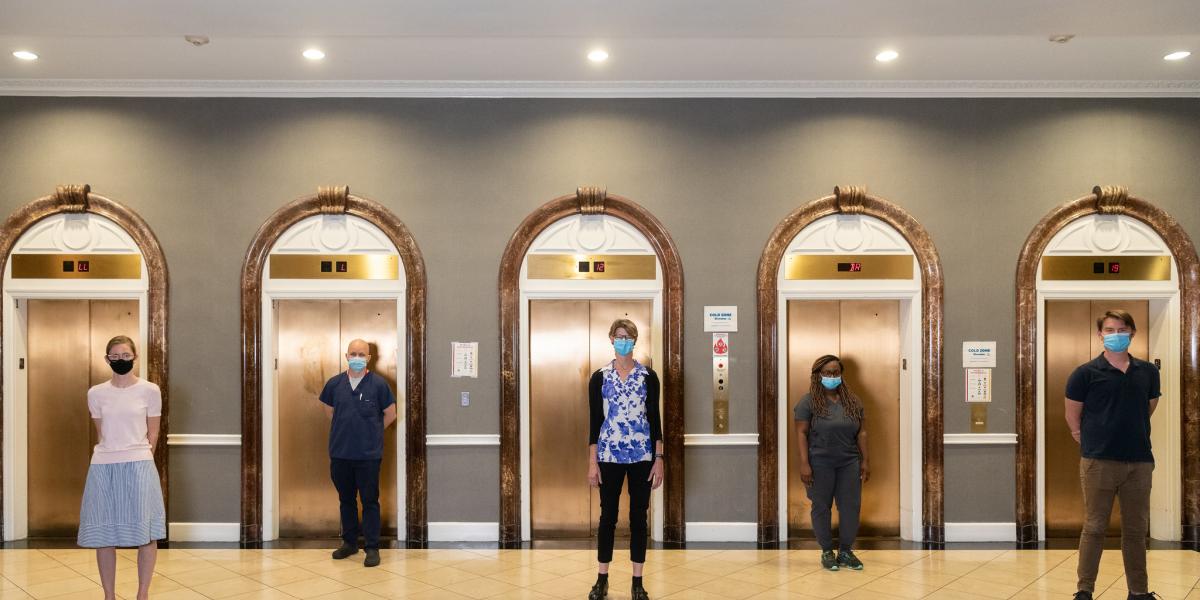COVID-19
Checking Out of Hotel COVID
One family’s story from the front lines of Baltimore’s pandemic healthcare response this year.
In darkness, I feel my way from bedroom to kitchen hugging the outside wall like liquid in a centrifuge. The place is strange, gray, and round like a spaceship, alien. As I tap through the living room into the hallway toward the kitchen, an orange laser beam shoots through a window and startles me closer to consciousness.
The radiant sliver widens over the Lego-like apartments at 225 North Calvert between St. Paul Plaza and the Blaustein Building at One North Charles. Then I remember: we are 21 stories above Baltimore, in a circular penthouse with windows open to every direction, and I just traveled from the shaded westside to dawn’s early light in the east.
My wife, two daughters, and I are in Hotel COVID, known prior to this pandemic as the Lord Baltimore.
I put water on to boil for the French press as a Warhol-esque portrait of Marilyn Monroe stares at me between two windows. Empty marinara-stained Styrofoam from Sabatino’s top the garbage can while recyclables spill out of two MICA tote bags—signs of just temporary domesticity.
Half the stuff in the kitchen—utensils, pots, and pans—belongs to the hotel and half is our family’s, which was transported in stages.
Five floors below us, and descending to the fourth floor of the Lord Baltimore Hotel, the rooms are filled with local residents diagnosed with COVID-19, or people who are highly suspected of having the illness. These residents (we do not call them “patients”) are not so symptomatic as to require hospitalization, but have been shuttled here from all over the Baltimore area because they could not safely isolate. They live in, and have come from, congregate settings such as shelters, substance-use recovery houses, multi-generational households, or on the street.
My wife, Marik Moen, is an RN and assistant professor of community and public health at the University of Maryland School of Nursing. She was invited to serve as the director of nursing here at the Lord Baltimore Hotel Triage Respite and Isolation Center, a collaborative effort of the Mayor’s Office of Homeless Services, the city health department, and the University of Maryland Medical System, with support from nonprofits like Healthcare for the Homeless Maryland.
In many cases, Healthcare for the Homeless identifies potential residents who may be well served by the Triage Respite and Isolation Center. The University of Maryland Medical System provides the healthcare, and the city oversees the operation, having entered into an agreement with the Miami-based Rubell family—the owners of the popular, 1928-built French Renaissance hotel—which had been all-but-vacant since March due to the state’s lockdown order.
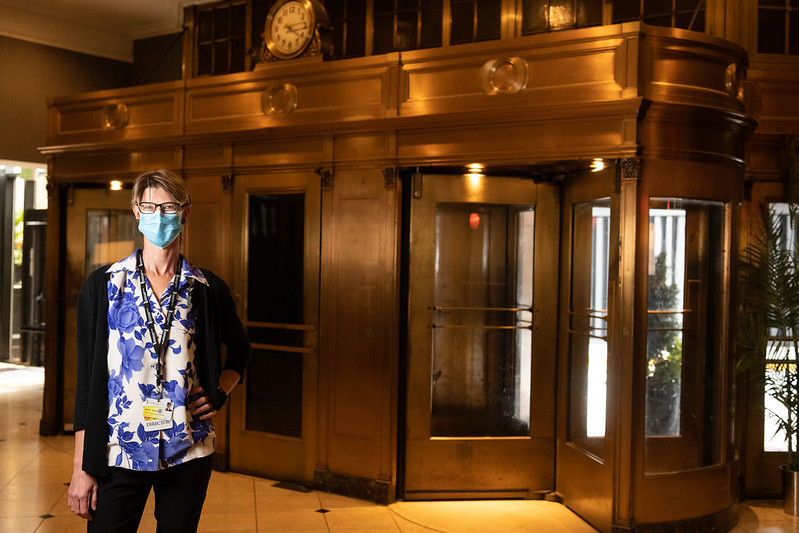
Two years earlier, we had moved from Baltimore to Fairfaix, Virginia when I took a job at George Mason University and Marik’s work life entered a research phase that required that she commute to Baltimore just a few days a week. Then the pandemic happened.
Characteristic of returned Peace Corps volunteers, Marik, who served in Gabon for three years before we were married, asked herself, “If not now, when? If not me, who?” So she reached out to the team pulling together the Baltimore Convention Center and, after an onboarding training, picked up some shifts.
In the early days of coronavirus, Baltimore enacted a plan similar to other cities that were transforming convention centers into field hospitals for COVID-19 patients who did not require intensive care. Then, in late April, weeks into the lockdown and wrapping up our semesters as professors while overseeing the ever-changing online schooling situation of our children, the phone rang.
It was Chuck Callahan, vice president of Population Health at the University of Maryland Medical Center. Marik and Chuck knew one another from a shared interest in population health and from the Convention Center project, which Chuck oversaw. I could not hear their full conversation, of course, but I distilled it as Chuck described the Lord Baltimore Hotel project—how the population being served exactly aligned with Marik’s service and research interests. I guessed correctly that he was asking whether she would head up the nursing component
I could tell by Marik’s voice, her hemming and hawing, as well as her energy and enthusiasm, what she was thinking. “If not now, when? If not me, who?”
Throughout the weekend, we must have walked around Lake Royal in Northern Virginia 50 times: back-burnering already back-burnered research goals and tenure-track requirements, discussing home-life and school-life that had suddenly become one life, and weighing the risk of infection and contamination.
“If not now, when?” “If not me, who?” Simple: Now. You. Us.
Marik departed for Baltimore on May 3. Driving back and forth from Fairfax, the extra steps required to keep the car clean and change her clothes upon first re-entering the house, to reduce the risk of contaminating us, did not make sense, so early on Marik simply stayed in Baltimore. We only occasionally saw her thereafter. During that first month, Marik stayed in a corner room on the 25th floor of the Crowne Plaza at Fayette and Liberty Streets. On weekends, we’d either drive up or she’d return to Fairfax to do laundry, purloin kitchen utensils, and swipe condiments.
On our first visit, before residents arrived at the Lord Baltimore, Marik gave us a tour. Armed guards greeted us just inside the lobby door off of Hanover Street where we rubbed hand sanitizer into our palms and took our temperatures. A hotel employee checked us in; otherwise, the large lobby was empty.
The ornate ceiling betrayed the hotel’s opulence, with a mauve and sage floral and diamond pattern accentuated with gilded edges. A grand piano sat silent and shadows cloaked the bar. Here roamed the ghosts of Amelia Earhart, Babe Ruth, Martin Luther King, Jr., and former Maryland governor Harry Hughes, who used the hotel as his gubernatorial campaign headquarters. In fact, paranormal experts claim the hotel—Baltimore’s tallest building when it was erected just before the Great Depression hit—is truly haunted. Guests have reported seeing the apparition of Molly, dressed in white and playing with a red ball, whose parents were apparently among the hotel’s “leapers.”
On the grand two-tiered ballroom level, Marik showed us the operation center where representatives from partnering organizations had set up workstations. Bowl-shaped crystal chandeliers still illuminated the space, gold sconces glowed from the columns, and long luxurious curtains graced the windows. But gone were the round tables draped in off-white linen, sparkling glassware, and formal place settings with silver cutlery. In their place were laptops and printers, a few rows of chairs set up for team meetings, cases of bottled water, file folders, and piles of masks.
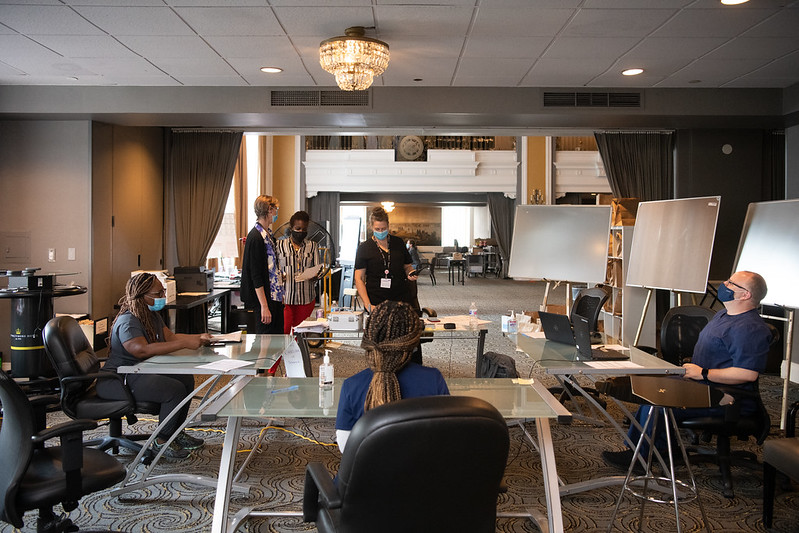
We returned to the lobby and faced a bank of four elevators. Inside the lifts, duct tape covered select buttons so that no one could inadvertently access a floor where COVID residents stayed. At every third floor, elevator doors opened on donning and doffing stations with industrial-strength plastic sealing doorways. (Staff could access the non-doffing floors only through the service elevators behind sealed hallways inside the “hot zone.” Residents accessed the floors via service elevators that connected with the loading dock area.)
The process for each TRI Center staffer involved entering an antechamber and donning personal protective equipment (N-95 mask, face shield, gown, gloves, booties), and next making rounds and using a pass-through room from the east side of the U-shaped floor to the west side. Then, at the end of a shift, doffing the PPE at the opposite antechamber. About 25 rooms per floor were in service, including smoking rooms, staff rooms, and pass-through rooms. Stairways were alarmed to prevent residents from using them but still allowing for emergency exits. In addition to PPE, nurses would be equipped with stethoscopes, thermometers, pulse oximeters, and blood pressure cuffs—just enough tools, along with their smarts and experience, to determine when a resident’s respiratory symptoms worsened or complications from a present comorbidity flared.
The first residents were due the Tuesday following our first family visit. We bought oysters and a rockfish from STREETS Market & Cafe and wine from Urban Cellars. We celebrated because it was clear that we wouldn’t be seeing much of each other. Then the kids and I returned to Virginia.
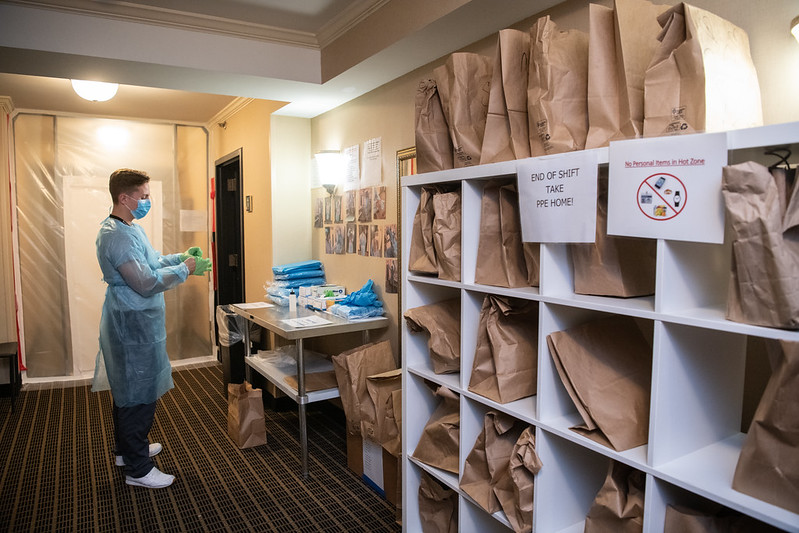
Residents arrived on May 12. Marik reported on challenges on the frontline: civilians working in but not understanding the clinical realm, droopy masks, mental health crises among some residents, others going on walk-abouts. Quarantine and cabin fever. The messiness of real life spilt over into Hotel COVID as problems that existed outside also existed here. Suddenly, a two-week reservation at the Lord Baltimore Hotel in the heart of beautiful downtown Charm City did not sound like a vacation at all.
In addition to navigating new professional relationships and corralling an entourage of mostly unfamiliar nurses, Marik got to know the hotel staff who tended to both their usual tasks and extraordinary new ones with a level of generosity not necessarily anticipated when your historic hotel morphs into a 2020 pandemic refuge. Perhaps most gracious was Onahlea Shimunek, the general manager of the Lord Baltimore, who has nearly 30 years of experience in hospitality.
Onahlea serves on the boards of such organizations as Back on My Feet, which combats homelessness through the power of running, community support, and employment and housing resources, and HealthCare Access Maryland. Naturally, she possesses a proclivity toward initiatives such as those currently occupying her 440-room hotel. Her LinkedIn page says that she “embraces challenges that create opportunities for the LBH team.” What could be more challenging than a triage, respite, and isolation center?
One might say Onahlea put the hospitality in “hospital.” She also knew the stress that working at Hotel COVID placed on Marik and her family, so she arranged for Marik to use one of the Lord Baltimore Hotel’s penthouses that came with an open invitation to us, which is how I have come to waking up several mornings a month feeling my way around the walls to the kitchen. Windows to the south overlooked the LB Skybar on the 19th Floor and the ledge from which Molly’s parents leapt.
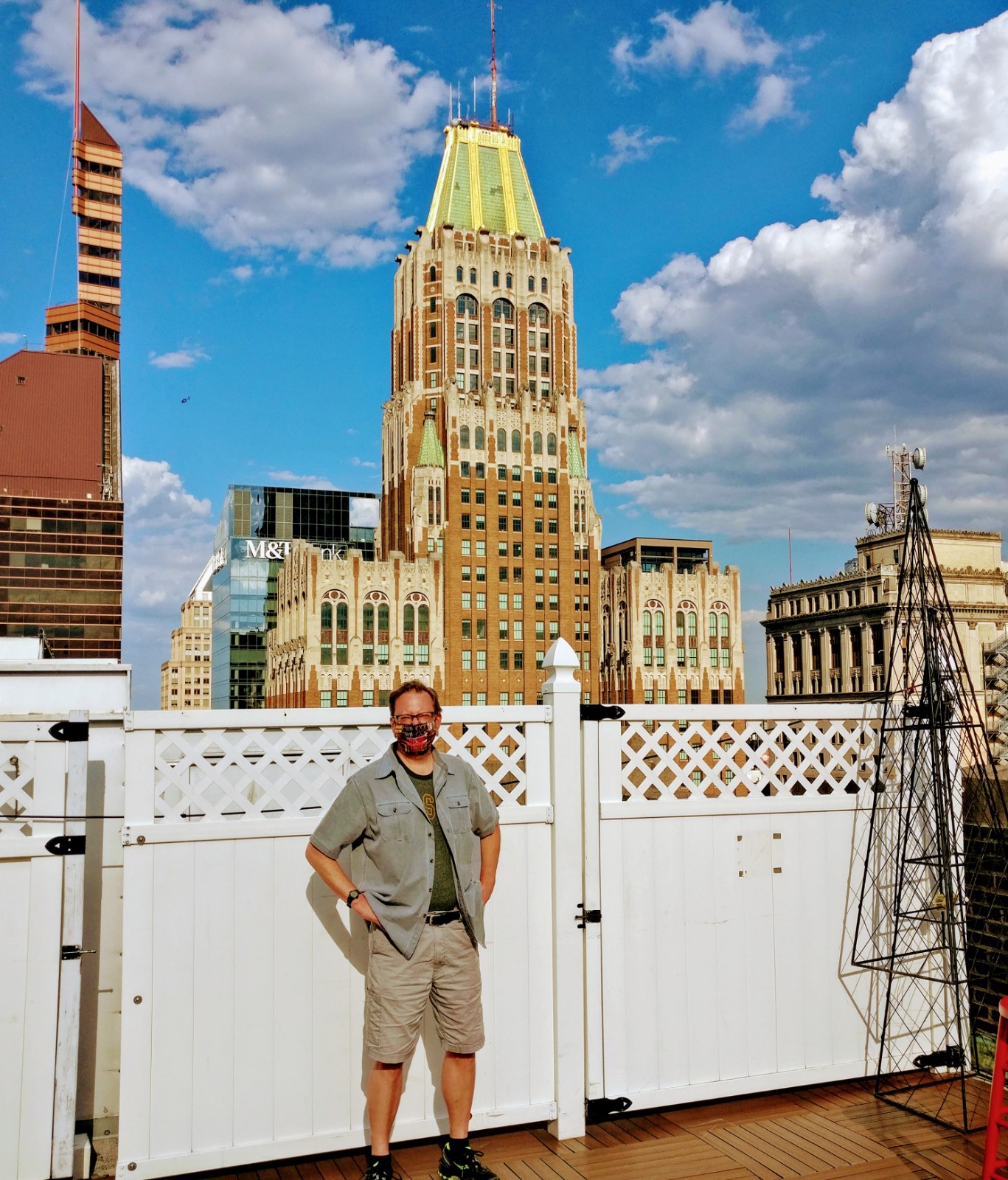
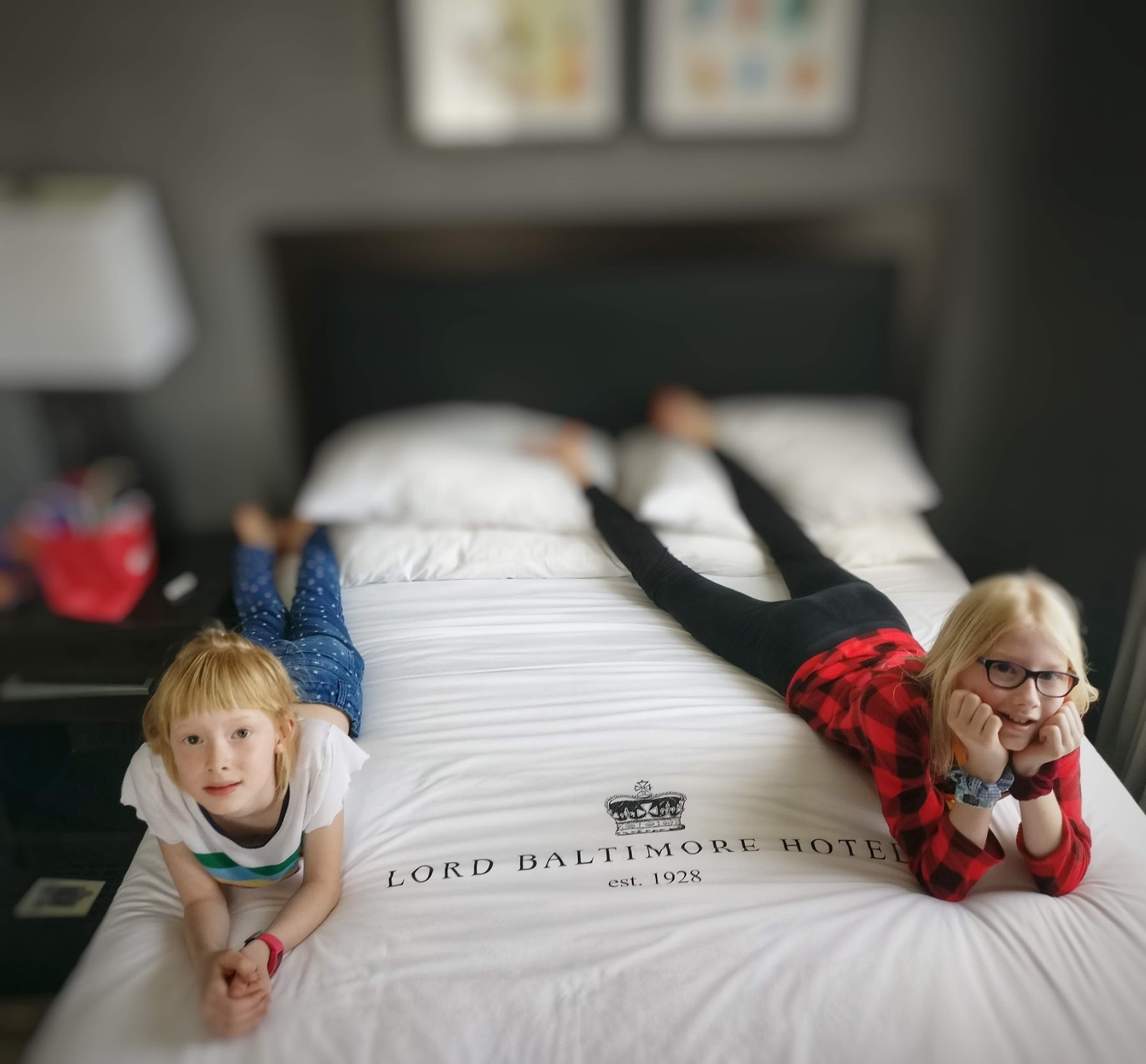
On Memorial Day, the same day Marik officially moved into Hotel COVID, a cop in her home state of Minnesota pressed his knee into George Floyd’s neck for more than eight minutes, killing him. A few days later, the kids and I packed clothes, laptops, books, and the packets that Fairfax County Public Schools mailed out and joined her. Same ritual each time entering the building: guards armed, hands cleaned, temperatures checked, express elevator to the 21st floor, and a 360-degree view of Baltimore.
On Friday, May 29, the first weekend after George Floyd’s murder and just over five years since the death of Freddie Gray while in police custody, I noticed from the bedroom window a few people walking down the middle of Liberty Street at Fayette. (Nothing unusual about Baltimoreans jay-walking.) Then, a few more bodies filtered through, then a cluster of a dozen, more, marching south.
Suddenly, a two-week reservation at the Lord Baltimore Hotel in the heart of beautiful downtown Charm City did not sound like a vacation at all.
I ran downstairs to join the flow of souls awash with demonstrators converging on downtown traffic along Light Street at Harborplace. A chorus call and response rose up: “I can’t breathe!” followed by “No justice, no peace!” That evening, the thwump, thwump, thwump of industrial HVAC fans on rooftops below the penthouse echoed the beat of helicopters that hovered above the city. The after-protest action on Saturday night was fierier than the previous night, with cars and dirt bikes making laps around blocks and against traffic deep into the early morning.
A few hours later, I feel my way through the suite to brew coffee and catch the solar uprising while humming a Joe Strummer tune (“I’m waiting for the rays of the morning sun. Somebody tell me, has the new world begun?”).
On Monday, June 1, Marik dressed and descended the elevator to the COVID-crisis below while the kids and I booted up for work and school. I constantly patrol the penthouse windows, around and around like a figurine in a Black Forest house cuckoo clock. Then it struck, at mid-afternoon, a torrent of demonstrators led by peaceful youth protesters cascading down Baltimore Street past the hotel heading toward City Hall. I dragged the girls downstairs, “You can’t miss this! You may not entirely understand it, but you must see it.”
Again, the next Saturday, a march from City Hall west along Fayette turning north on Charles Street toward the Washington Monument. Again, I masked the kids and dragged them out in hopes that the indelible impression would lead to more serious conversations, maybe today, maybe tomorrow as they grow older. We stood in the intersection: “This is important stuff girls, look at it, look at it hard.” Masked demonstrators filed past us: “Dismantle Racist Police State,” “How Many More Times Does This Shit Have to Happen Until Black Lives Matter?,” “Enough is Enough.” A thousand hand-held placards. Look hard.
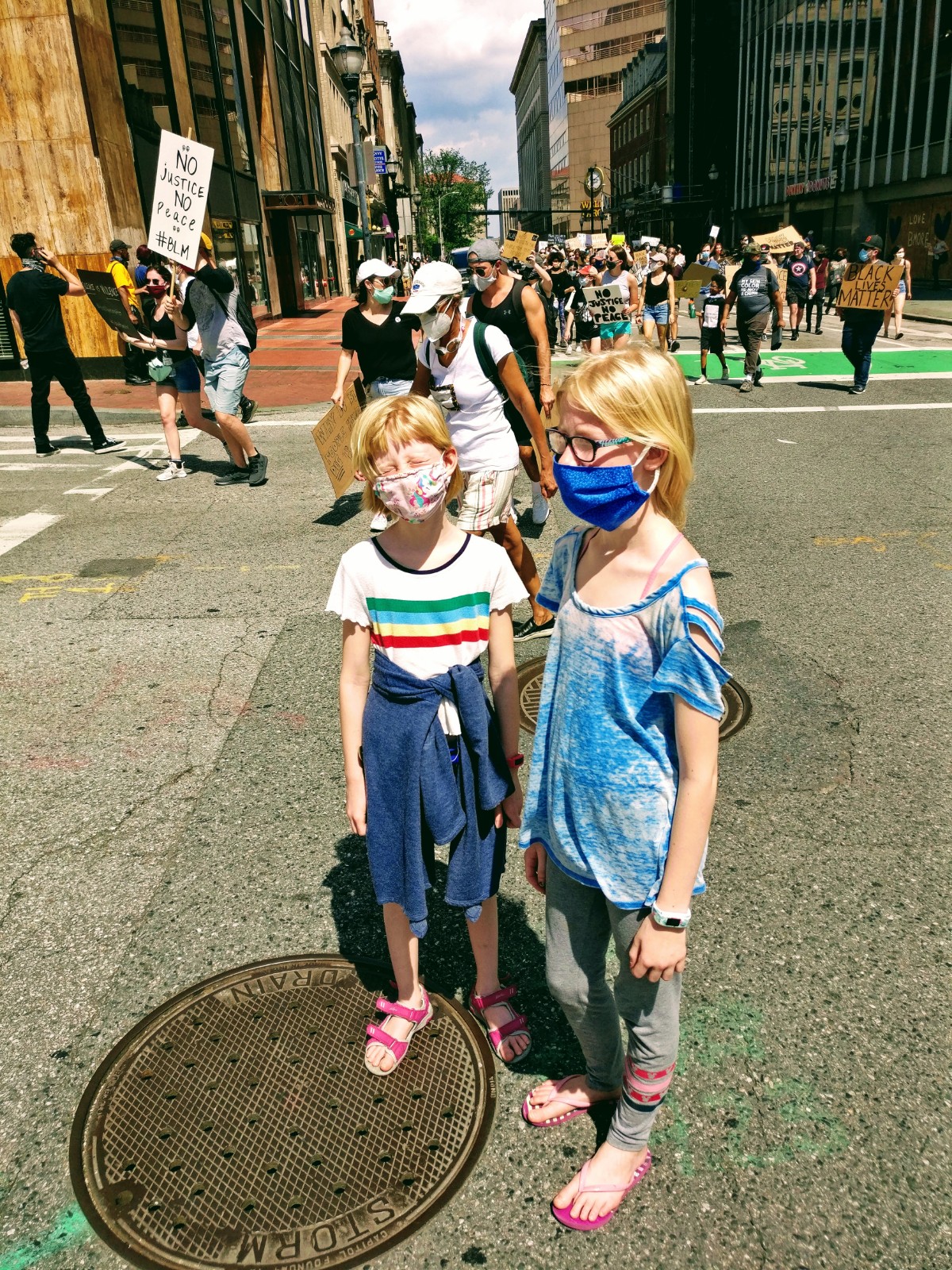
Then we returned to the penthouse at the Hotel COVID, where we could rise above it all, an act of privilege that demanded to be acknowledged.
COVID-19 uprooted our lives, as it did for tens of thousands of families, with more dire consequences for far too many. For us, it meant Mom left for the TRI Center at the Lord Baltimore Hotel while I worked remotely, taught ineffectually, and oversaw lamely the final weeks of second and fourth grade for our kids from “home.” Although her time at the TRI Center would conclude at the end of summer, Marik’s public health career would continue to rattle her world and compel her to be on site, whereas my higher ed world would struggle to reimagine its future when its past hinged on bodies physically being on campus. With our lease due for renewal, we rolled the dice and started house hunting in Baltimore.
I told Marik that the unprecedented situation dictated the move. In fact, I was homesick.
On July 17, we closed on a house and moved back home to Baltimore. (I recognized one trustee’s name on the contract, a writer whose husband is a painter whose prints hung on our walls. The other trustee’s name was an estate lawyer and partner of a colleague of mine from when I worked at MICA. And the seller’s niece was a nurse practitioner who worked at the TRI Center with Marik. In other words, the quintessential Smalltimore signs of making a good decision.)
Then we returned to the penthouse at the Hotel COVID, where we could rise above it all, an act of privilege that demanded to be acknowledged.
The next weekend, Marik collected things that had accumulated at Hotel COVID and officially checked out. Her time with this project ended in early September. On the Sunday of Labor Day weekend, Marik’s phone buzzed the way it did most mornings just after 5:30 a.m. when the day’s staffing needs started to jostle. Nurses were needed at the Lord Baltimore, but Marik had checked out—even though I think a standing reservation is on hold for her.
As of this fall, the TRI Center had served more than 750 residents, saving lives due to close monitoring and triage to higher levels of care if residents’ conditions worsened. The team prevented countless infections by isolating positive people from the wider population and stemming the chain of transmission. The Lord Baltimore Hotel Triage Respite and Isolation Center will continue to operate through December, or as long as the epidemic still demands a Hotel COVID.
As of this writing, President-Elect Biden’s transition team attempts to coordinate a more unified response to the pandemic while the outgoing administration struggles with the resurgent coronavirus. It’s as bad as March, rates of infection higher than even the summer. And as Marik takes more shifts and the TRI Center team reaches out for support, I’m reminded of the classic Eagle’s song: You can check out of Hotel COVID, but you can never leave.
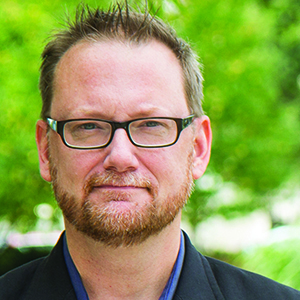
Gregg Wilhelm is the founder and former executive director of CityLit Project in Baltimore and director of the Creative Writing Program at George Mason University in Fairfax.
